Financial Accounting Report: Regulations, Statements, and Analysis
VerifiedAdded on 2020/07/23
|46
|4321
|262
Report
AI Summary
This report provides a comprehensive overview of financial accounting principles and practices. It begins with an introduction to financial accounting, its regulations, and the role of accounting principles in preparing accurate financial statements. The report then delves into specific aspects of financial accounting, including journal entries, ledger accounts, trial balances, income statements, and balance sheets for various clients. It covers topics such as the concepts of material disclosure and consistency, depreciation methods, bank reconciliation, and the preparation of sales and purchase ledger accounts. The report also includes discussions on control accounts, suspense accounts, and the application of accounting methods. Overall, the report offers a detailed analysis of financial accounting concepts, practical applications, and the importance of accurate financial reporting for decision-making.
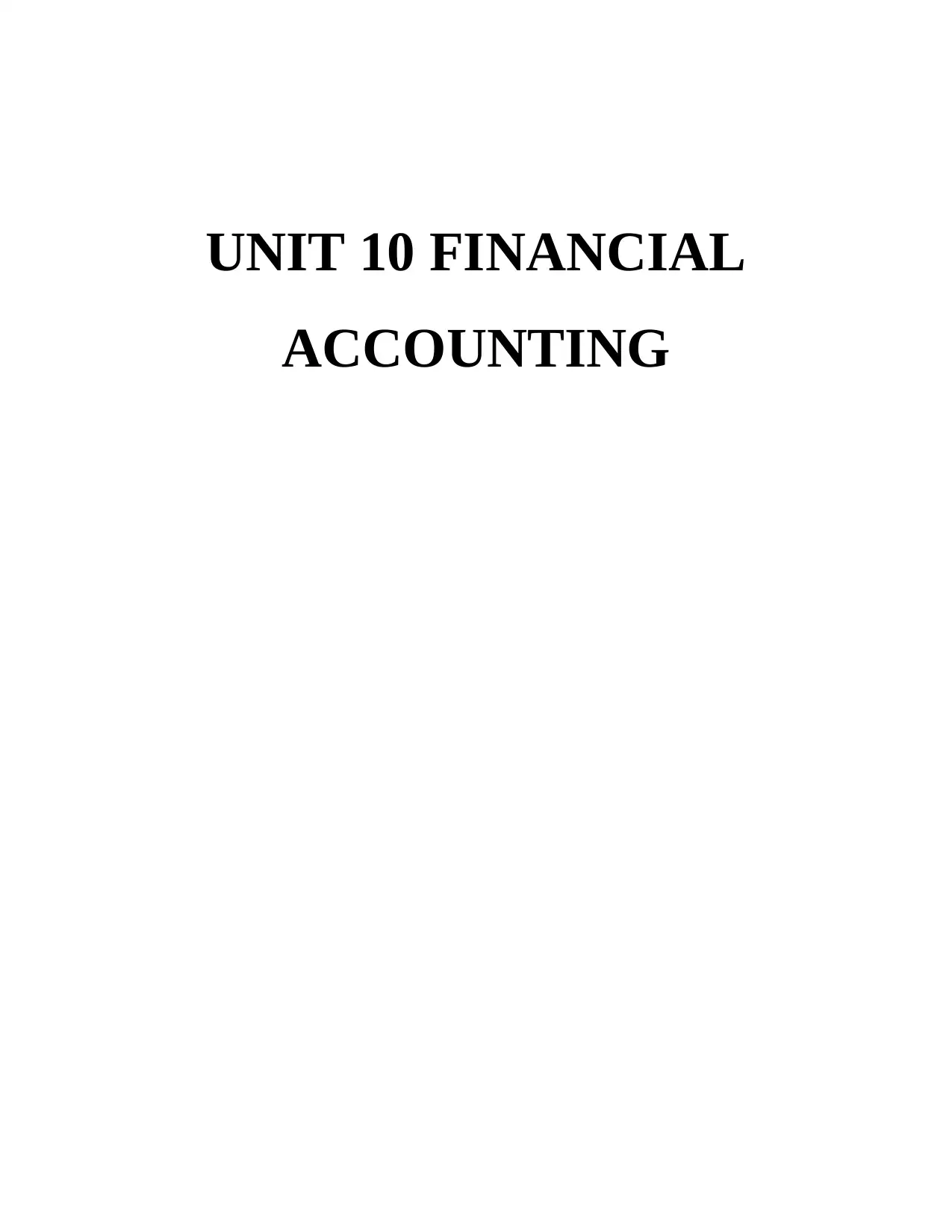
UNIT 10 FINANCIAL
ACCOUNTING
ACCOUNTING
Paraphrase This Document
Need a fresh take? Get an instant paraphrase of this document with our AI Paraphraser
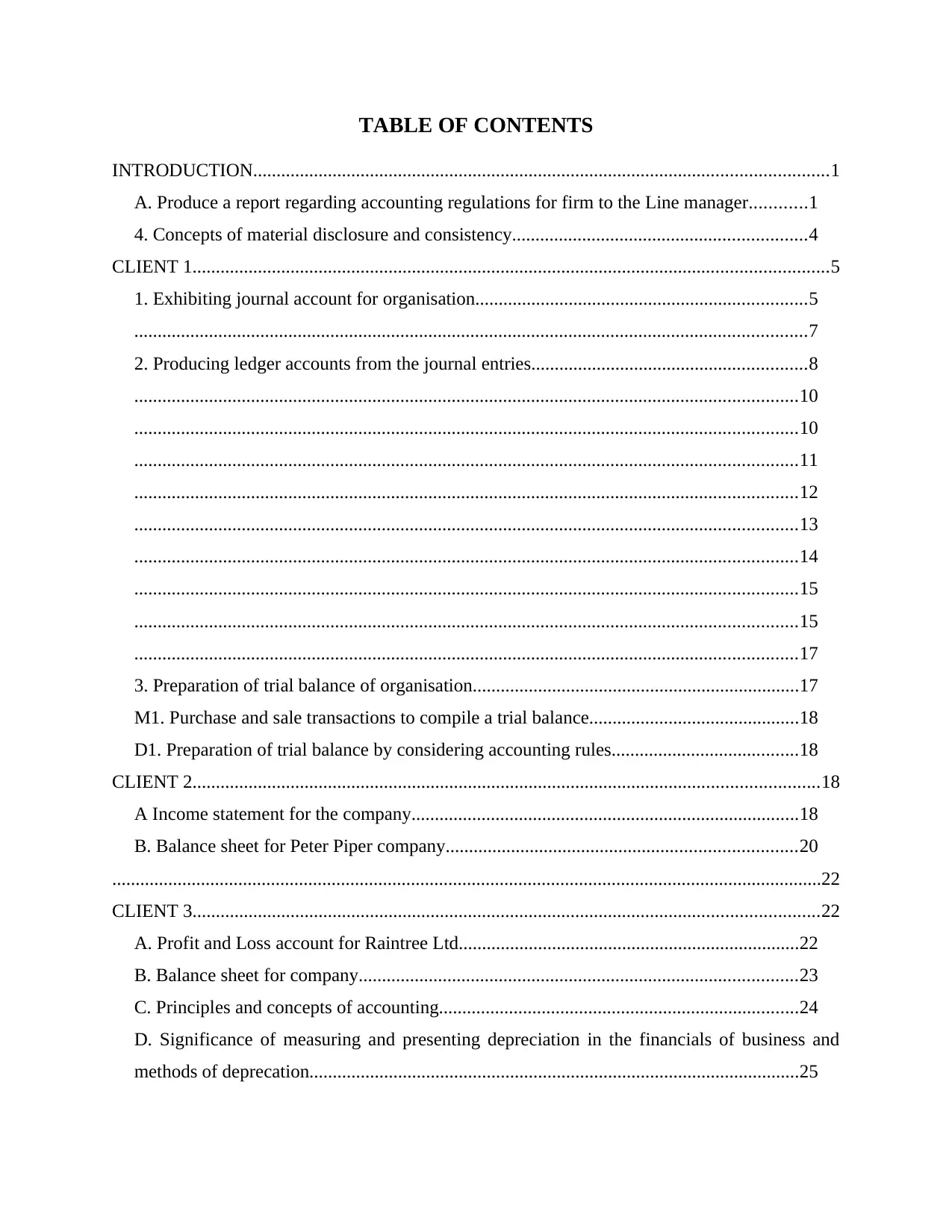
TABLE OF CONTENTS
INTRODUCTION...........................................................................................................................1
A. Produce a report regarding accounting regulations for firm to the Line manager............1
4. Concepts of material disclosure and consistency...............................................................4
CLIENT 1........................................................................................................................................5
1. Exhibiting journal account for organisation.......................................................................5
................................................................................................................................................7
2. Producing ledger accounts from the journal entries...........................................................8
..............................................................................................................................................10
..............................................................................................................................................10
..............................................................................................................................................11
..............................................................................................................................................12
..............................................................................................................................................13
..............................................................................................................................................14
..............................................................................................................................................15
..............................................................................................................................................15
..............................................................................................................................................17
3. Preparation of trial balance of organisation......................................................................17
M1. Purchase and sale transactions to compile a trial balance.............................................18
D1. Preparation of trial balance by considering accounting rules........................................18
CLIENT 2......................................................................................................................................18
A Income statement for the company...................................................................................18
B. Balance sheet for Peter Piper company...........................................................................20
........................................................................................................................................................22
CLIENT 3......................................................................................................................................22
A. Profit and Loss account for Raintree Ltd.........................................................................22
B. Balance sheet for company..............................................................................................23
C. Principles and concepts of accounting.............................................................................24
D. Significance of measuring and presenting depreciation in the financials of business and
methods of deprecation.........................................................................................................25
INTRODUCTION...........................................................................................................................1
A. Produce a report regarding accounting regulations for firm to the Line manager............1
4. Concepts of material disclosure and consistency...............................................................4
CLIENT 1........................................................................................................................................5
1. Exhibiting journal account for organisation.......................................................................5
................................................................................................................................................7
2. Producing ledger accounts from the journal entries...........................................................8
..............................................................................................................................................10
..............................................................................................................................................10
..............................................................................................................................................11
..............................................................................................................................................12
..............................................................................................................................................13
..............................................................................................................................................14
..............................................................................................................................................15
..............................................................................................................................................15
..............................................................................................................................................17
3. Preparation of trial balance of organisation......................................................................17
M1. Purchase and sale transactions to compile a trial balance.............................................18
D1. Preparation of trial balance by considering accounting rules........................................18
CLIENT 2......................................................................................................................................18
A Income statement for the company...................................................................................18
B. Balance sheet for Peter Piper company...........................................................................20
........................................................................................................................................................22
CLIENT 3......................................................................................................................................22
A. Profit and Loss account for Raintree Ltd.........................................................................22
B. Balance sheet for company..............................................................................................23
C. Principles and concepts of accounting.............................................................................24
D. Significance of measuring and presenting depreciation in the financials of business and
methods of deprecation.........................................................................................................25
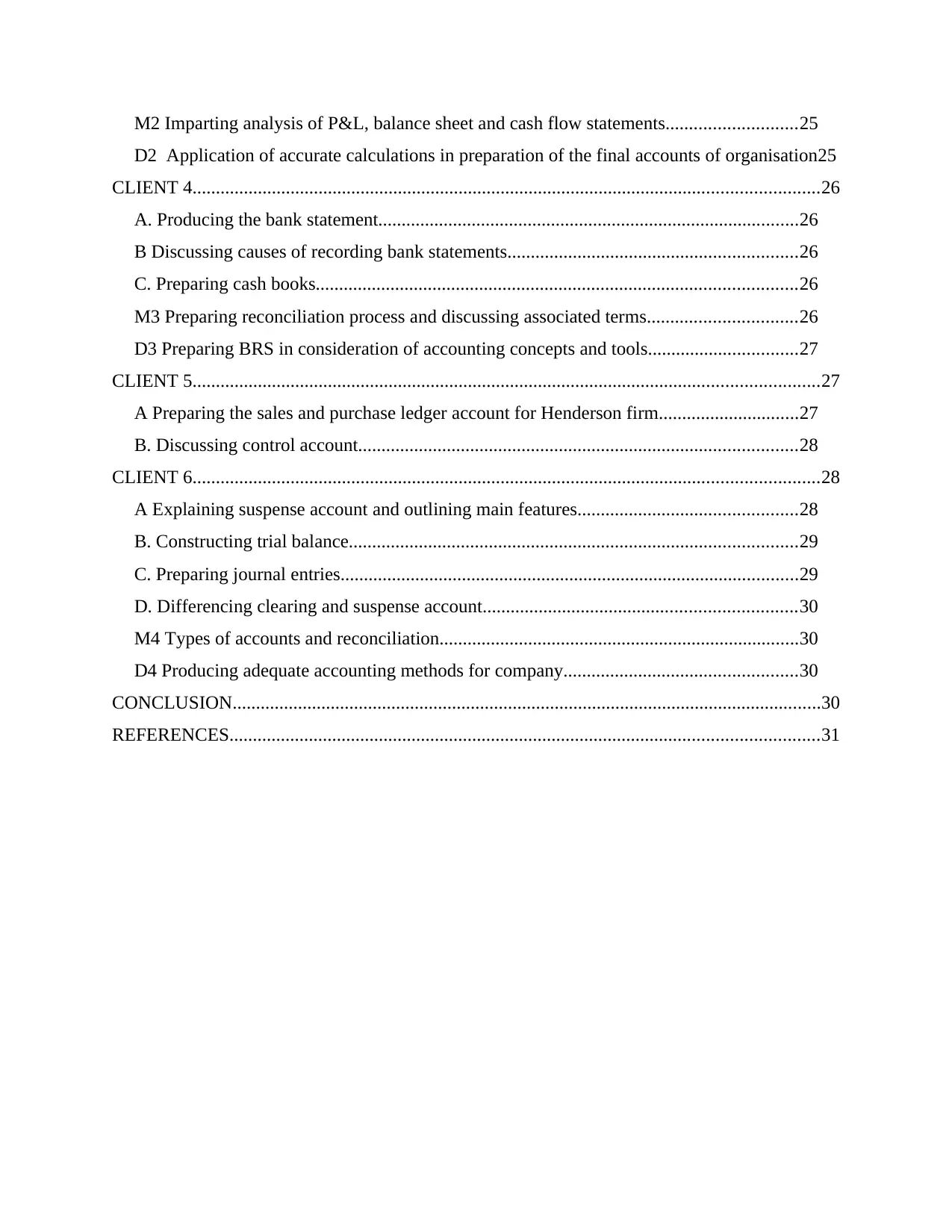
M2 Imparting analysis of P&L, balance sheet and cash flow statements............................25
D2 Application of accurate calculations in preparation of the final accounts of organisation25
CLIENT 4......................................................................................................................................26
A. Producing the bank statement..........................................................................................26
B Discussing causes of recording bank statements..............................................................26
C. Preparing cash books.......................................................................................................26
M3 Preparing reconciliation process and discussing associated terms................................26
D3 Preparing BRS in consideration of accounting concepts and tools................................27
CLIENT 5......................................................................................................................................27
A Preparing the sales and purchase ledger account for Henderson firm..............................27
B. Discussing control account..............................................................................................28
CLIENT 6......................................................................................................................................28
A Explaining suspense account and outlining main features...............................................28
B. Constructing trial balance................................................................................................29
C. Preparing journal entries..................................................................................................29
D. Differencing clearing and suspense account...................................................................30
M4 Types of accounts and reconciliation.............................................................................30
D4 Producing adequate accounting methods for company..................................................30
CONCLUSION..............................................................................................................................30
REFERENCES..............................................................................................................................31
D2 Application of accurate calculations in preparation of the final accounts of organisation25
CLIENT 4......................................................................................................................................26
A. Producing the bank statement..........................................................................................26
B Discussing causes of recording bank statements..............................................................26
C. Preparing cash books.......................................................................................................26
M3 Preparing reconciliation process and discussing associated terms................................26
D3 Preparing BRS in consideration of accounting concepts and tools................................27
CLIENT 5......................................................................................................................................27
A Preparing the sales and purchase ledger account for Henderson firm..............................27
B. Discussing control account..............................................................................................28
CLIENT 6......................................................................................................................................28
A Explaining suspense account and outlining main features...............................................28
B. Constructing trial balance................................................................................................29
C. Preparing journal entries..................................................................................................29
D. Differencing clearing and suspense account...................................................................30
M4 Types of accounts and reconciliation.............................................................................30
D4 Producing adequate accounting methods for company..................................................30
CONCLUSION..............................................................................................................................30
REFERENCES..............................................................................................................................31
⊘ This is a preview!⊘
Do you want full access?
Subscribe today to unlock all pages.

Trusted by 1+ million students worldwide
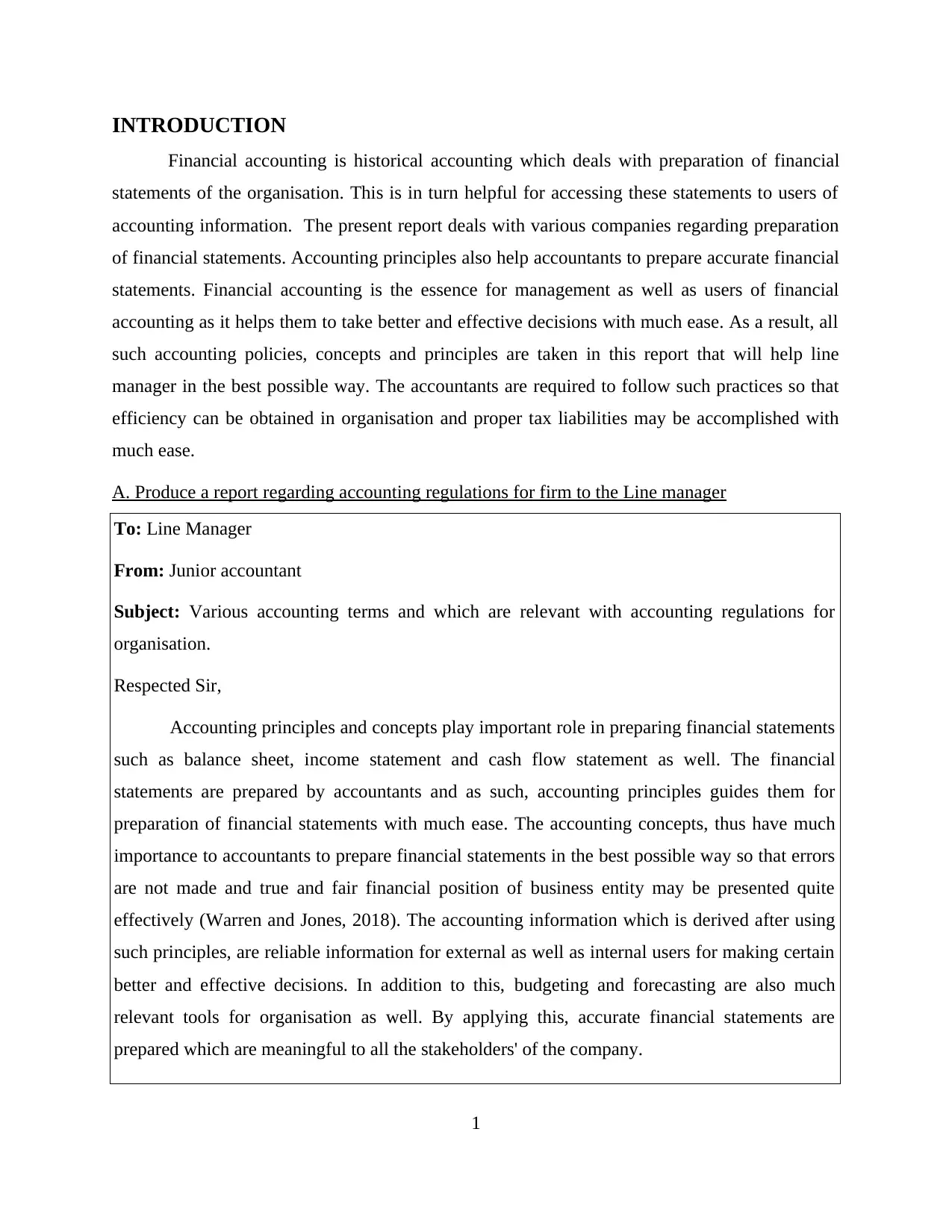
INTRODUCTION
Financial accounting is historical accounting which deals with preparation of financial
statements of the organisation. This is in turn helpful for accessing these statements to users of
accounting information. The present report deals with various companies regarding preparation
of financial statements. Accounting principles also help accountants to prepare accurate financial
statements. Financial accounting is the essence for management as well as users of financial
accounting as it helps them to take better and effective decisions with much ease. As a result, all
such accounting policies, concepts and principles are taken in this report that will help line
manager in the best possible way. The accountants are required to follow such practices so that
efficiency can be obtained in organisation and proper tax liabilities may be accomplished with
much ease.
A. Produce a report regarding accounting regulations for firm to the Line manager
To: Line Manager
From: Junior accountant
Subject: Various accounting terms and which are relevant with accounting regulations for
organisation.
Respected Sir,
Accounting principles and concepts play important role in preparing financial statements
such as balance sheet, income statement and cash flow statement as well. The financial
statements are prepared by accountants and as such, accounting principles guides them for
preparation of financial statements with much ease. The accounting concepts, thus have much
importance to accountants to prepare financial statements in the best possible way so that errors
are not made and true and fair financial position of business entity may be presented quite
effectively (Warren and Jones, 2018). The accounting information which is derived after using
such principles, are reliable information for external as well as internal users for making certain
better and effective decisions. In addition to this, budgeting and forecasting are also much
relevant tools for organisation as well. By applying this, accurate financial statements are
prepared which are meaningful to all the stakeholders' of the company.
1
Financial accounting is historical accounting which deals with preparation of financial
statements of the organisation. This is in turn helpful for accessing these statements to users of
accounting information. The present report deals with various companies regarding preparation
of financial statements. Accounting principles also help accountants to prepare accurate financial
statements. Financial accounting is the essence for management as well as users of financial
accounting as it helps them to take better and effective decisions with much ease. As a result, all
such accounting policies, concepts and principles are taken in this report that will help line
manager in the best possible way. The accountants are required to follow such practices so that
efficiency can be obtained in organisation and proper tax liabilities may be accomplished with
much ease.
A. Produce a report regarding accounting regulations for firm to the Line manager
To: Line Manager
From: Junior accountant
Subject: Various accounting terms and which are relevant with accounting regulations for
organisation.
Respected Sir,
Accounting principles and concepts play important role in preparing financial statements
such as balance sheet, income statement and cash flow statement as well. The financial
statements are prepared by accountants and as such, accounting principles guides them for
preparation of financial statements with much ease. The accounting concepts, thus have much
importance to accountants to prepare financial statements in the best possible way so that errors
are not made and true and fair financial position of business entity may be presented quite
effectively (Warren and Jones, 2018). The accounting information which is derived after using
such principles, are reliable information for external as well as internal users for making certain
better and effective decisions. In addition to this, budgeting and forecasting are also much
relevant tools for organisation as well. By applying this, accurate financial statements are
prepared which are meaningful to all the stakeholders' of the company.
1
Paraphrase This Document
Need a fresh take? Get an instant paraphrase of this document with our AI Paraphraser
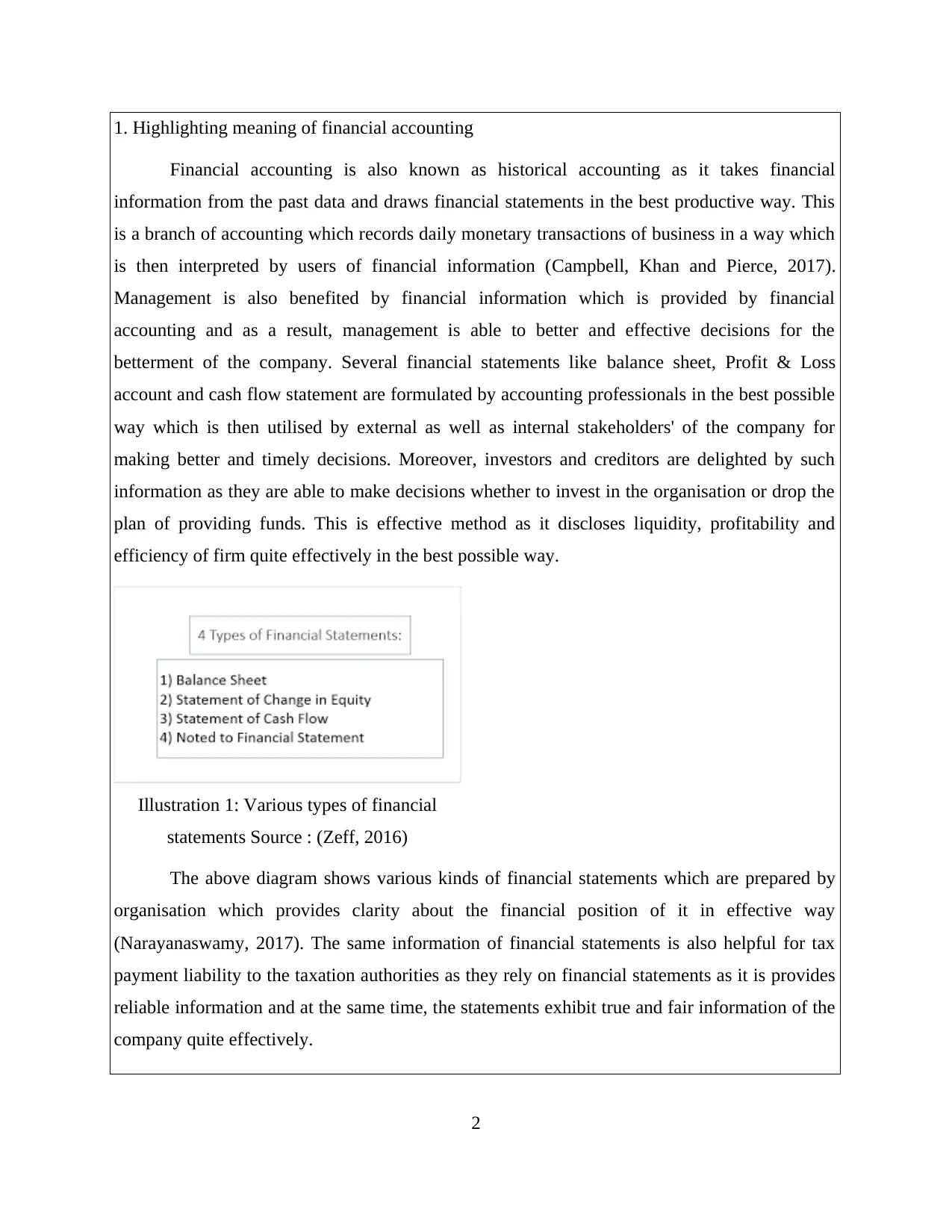
1. Highlighting meaning of financial accounting
Financial accounting is also known as historical accounting as it takes financial
information from the past data and draws financial statements in the best productive way. This
is a branch of accounting which records daily monetary transactions of business in a way which
is then interpreted by users of financial information (Campbell, Khan and Pierce, 2017).
Management is also benefited by financial information which is provided by financial
accounting and as a result, management is able to better and effective decisions for the
betterment of the company. Several financial statements like balance sheet, Profit & Loss
account and cash flow statement are formulated by accounting professionals in the best possible
way which is then utilised by external as well as internal stakeholders' of the company for
making better and timely decisions. Moreover, investors and creditors are delighted by such
information as they are able to make decisions whether to invest in the organisation or drop the
plan of providing funds. This is effective method as it discloses liquidity, profitability and
efficiency of firm quite effectively in the best possible way.
Illustration 1: Various types of financial
statements Source : (Zeff, 2016)
The above diagram shows various kinds of financial statements which are prepared by
organisation which provides clarity about the financial position of it in effective way
(Narayanaswamy, 2017). The same information of financial statements is also helpful for tax
payment liability to the taxation authorities as they rely on financial statements as it is provides
reliable information and at the same time, the statements exhibit true and fair information of the
company quite effectively.
2
Financial accounting is also known as historical accounting as it takes financial
information from the past data and draws financial statements in the best productive way. This
is a branch of accounting which records daily monetary transactions of business in a way which
is then interpreted by users of financial information (Campbell, Khan and Pierce, 2017).
Management is also benefited by financial information which is provided by financial
accounting and as a result, management is able to better and effective decisions for the
betterment of the company. Several financial statements like balance sheet, Profit & Loss
account and cash flow statement are formulated by accounting professionals in the best possible
way which is then utilised by external as well as internal stakeholders' of the company for
making better and timely decisions. Moreover, investors and creditors are delighted by such
information as they are able to make decisions whether to invest in the organisation or drop the
plan of providing funds. This is effective method as it discloses liquidity, profitability and
efficiency of firm quite effectively in the best possible way.
Illustration 1: Various types of financial
statements Source : (Zeff, 2016)
The above diagram shows various kinds of financial statements which are prepared by
organisation which provides clarity about the financial position of it in effective way
(Narayanaswamy, 2017). The same information of financial statements is also helpful for tax
payment liability to the taxation authorities as they rely on financial statements as it is provides
reliable information and at the same time, the statements exhibit true and fair information of the
company quite effectively.
2
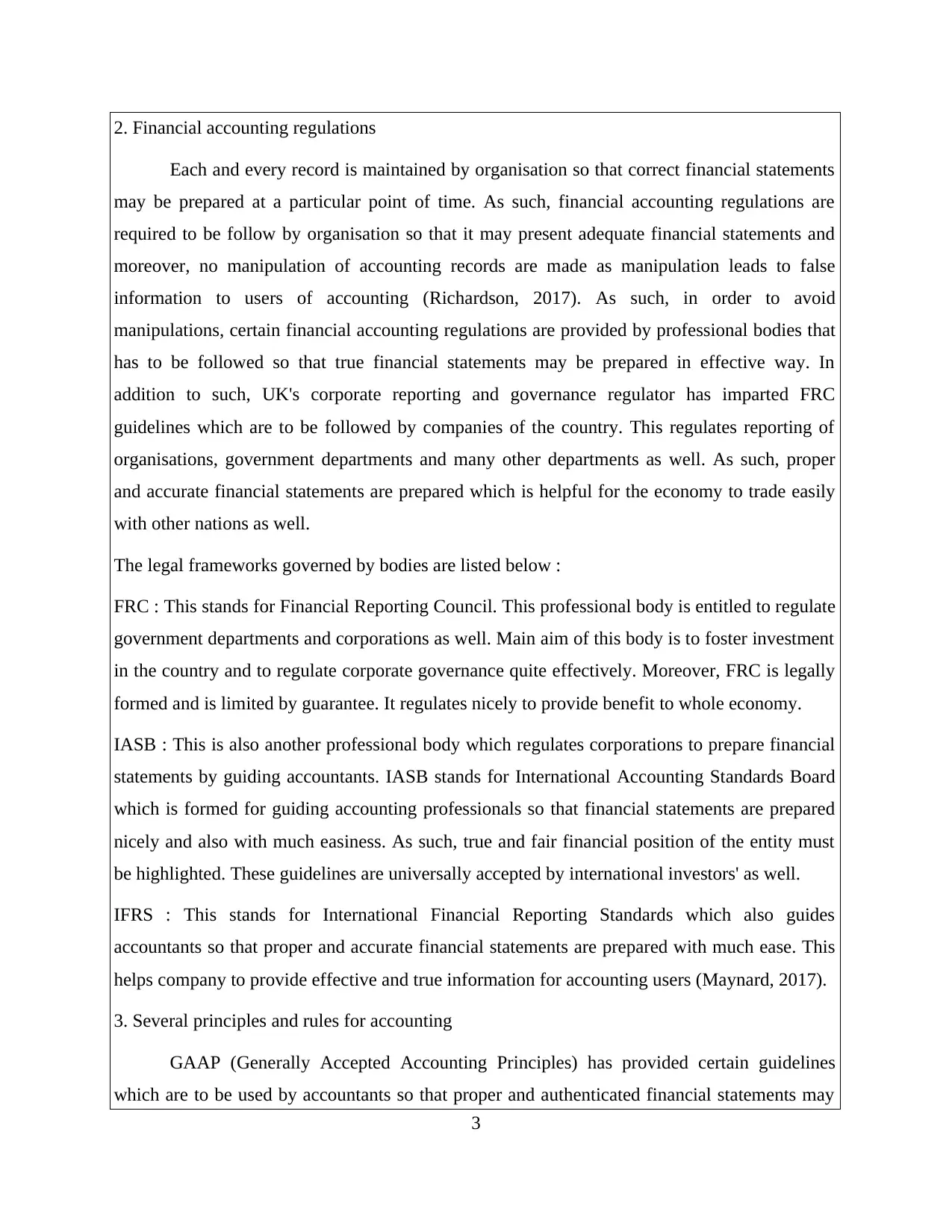
2. Financial accounting regulations
Each and every record is maintained by organisation so that correct financial statements
may be prepared at a particular point of time. As such, financial accounting regulations are
required to be follow by organisation so that it may present adequate financial statements and
moreover, no manipulation of accounting records are made as manipulation leads to false
information to users of accounting (Richardson, 2017). As such, in order to avoid
manipulations, certain financial accounting regulations are provided by professional bodies that
has to be followed so that true financial statements may be prepared in effective way. In
addition to such, UK's corporate reporting and governance regulator has imparted FRC
guidelines which are to be followed by companies of the country. This regulates reporting of
organisations, government departments and many other departments as well. As such, proper
and accurate financial statements are prepared which is helpful for the economy to trade easily
with other nations as well.
The legal frameworks governed by bodies are listed below :
FRC : This stands for Financial Reporting Council. This professional body is entitled to regulate
government departments and corporations as well. Main aim of this body is to foster investment
in the country and to regulate corporate governance quite effectively. Moreover, FRC is legally
formed and is limited by guarantee. It regulates nicely to provide benefit to whole economy.
IASB : This is also another professional body which regulates corporations to prepare financial
statements by guiding accountants. IASB stands for International Accounting Standards Board
which is formed for guiding accounting professionals so that financial statements are prepared
nicely and also with much easiness. As such, true and fair financial position of the entity must
be highlighted. These guidelines are universally accepted by international investors' as well.
IFRS : This stands for International Financial Reporting Standards which also guides
accountants so that proper and accurate financial statements are prepared with much ease. This
helps company to provide effective and true information for accounting users (Maynard, 2017).
3. Several principles and rules for accounting
GAAP (Generally Accepted Accounting Principles) has provided certain guidelines
which are to be used by accountants so that proper and authenticated financial statements may
3
Each and every record is maintained by organisation so that correct financial statements
may be prepared at a particular point of time. As such, financial accounting regulations are
required to be follow by organisation so that it may present adequate financial statements and
moreover, no manipulation of accounting records are made as manipulation leads to false
information to users of accounting (Richardson, 2017). As such, in order to avoid
manipulations, certain financial accounting regulations are provided by professional bodies that
has to be followed so that true financial statements may be prepared in effective way. In
addition to such, UK's corporate reporting and governance regulator has imparted FRC
guidelines which are to be followed by companies of the country. This regulates reporting of
organisations, government departments and many other departments as well. As such, proper
and accurate financial statements are prepared which is helpful for the economy to trade easily
with other nations as well.
The legal frameworks governed by bodies are listed below :
FRC : This stands for Financial Reporting Council. This professional body is entitled to regulate
government departments and corporations as well. Main aim of this body is to foster investment
in the country and to regulate corporate governance quite effectively. Moreover, FRC is legally
formed and is limited by guarantee. It regulates nicely to provide benefit to whole economy.
IASB : This is also another professional body which regulates corporations to prepare financial
statements by guiding accountants. IASB stands for International Accounting Standards Board
which is formed for guiding accounting professionals so that financial statements are prepared
nicely and also with much easiness. As such, true and fair financial position of the entity must
be highlighted. These guidelines are universally accepted by international investors' as well.
IFRS : This stands for International Financial Reporting Standards which also guides
accountants so that proper and accurate financial statements are prepared with much ease. This
helps company to provide effective and true information for accounting users (Maynard, 2017).
3. Several principles and rules for accounting
GAAP (Generally Accepted Accounting Principles) has provided certain guidelines
which are to be used by accountants so that proper and authenticated financial statements may
3
⊘ This is a preview!⊘
Do you want full access?
Subscribe today to unlock all pages.

Trusted by 1+ million students worldwide
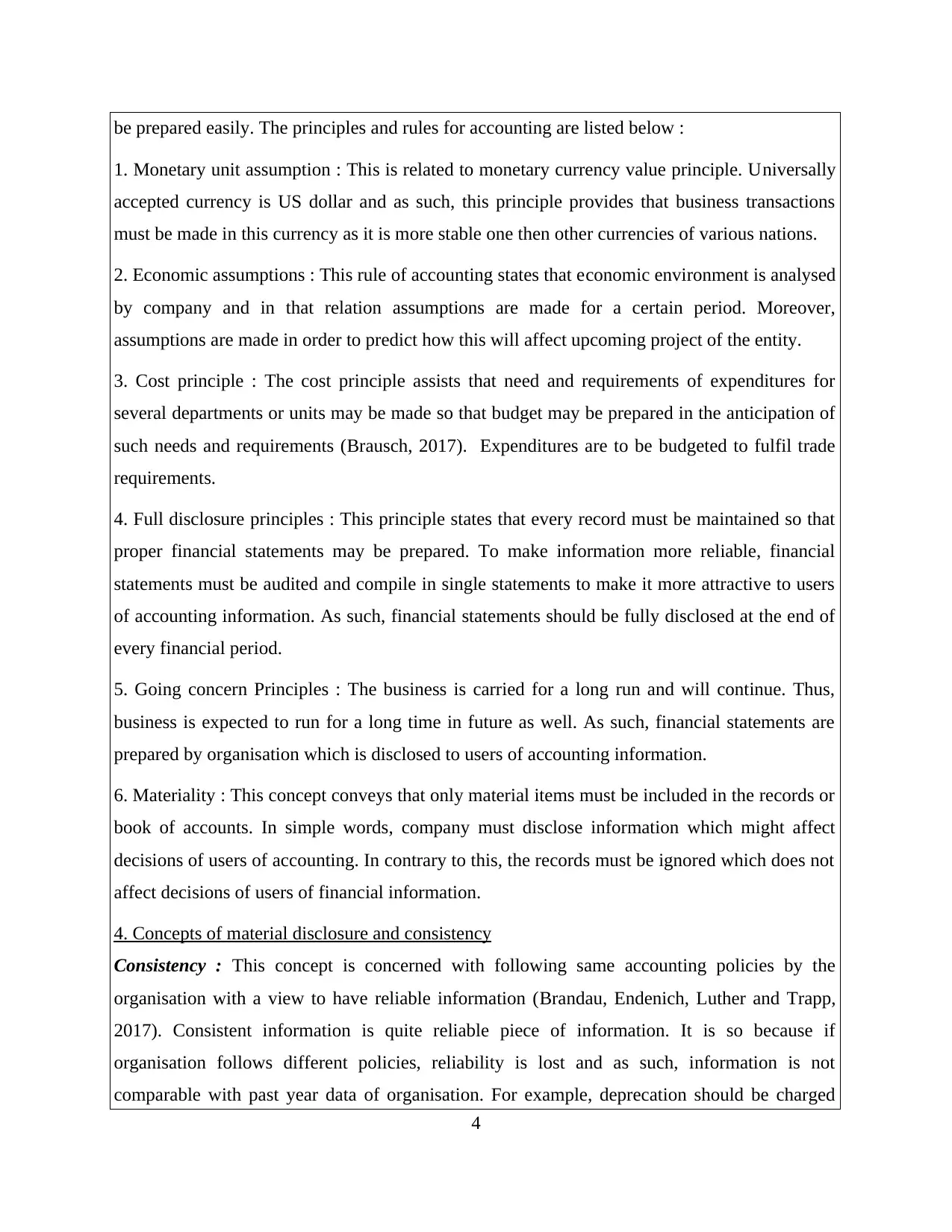
be prepared easily. The principles and rules for accounting are listed below :
1. Monetary unit assumption : This is related to monetary currency value principle. Universally
accepted currency is US dollar and as such, this principle provides that business transactions
must be made in this currency as it is more stable one then other currencies of various nations.
2. Economic assumptions : This rule of accounting states that economic environment is analysed
by company and in that relation assumptions are made for a certain period. Moreover,
assumptions are made in order to predict how this will affect upcoming project of the entity.
3. Cost principle : The cost principle assists that need and requirements of expenditures for
several departments or units may be made so that budget may be prepared in the anticipation of
such needs and requirements (Brausch, 2017). Expenditures are to be budgeted to fulfil trade
requirements.
4. Full disclosure principles : This principle states that every record must be maintained so that
proper financial statements may be prepared. To make information more reliable, financial
statements must be audited and compile in single statements to make it more attractive to users
of accounting information. As such, financial statements should be fully disclosed at the end of
every financial period.
5. Going concern Principles : The business is carried for a long run and will continue. Thus,
business is expected to run for a long time in future as well. As such, financial statements are
prepared by organisation which is disclosed to users of accounting information.
6. Materiality : This concept conveys that only material items must be included in the records or
book of accounts. In simple words, company must disclose information which might affect
decisions of users of accounting. In contrary to this, the records must be ignored which does not
affect decisions of users of financial information.
4. Concepts of material disclosure and consistency
Consistency : This concept is concerned with following same accounting policies by the
organisation with a view to have reliable information (Brandau, Endenich, Luther and Trapp,
2017). Consistent information is quite reliable piece of information. It is so because if
organisation follows different policies, reliability is lost and as such, information is not
comparable with past year data of organisation. For example, deprecation should be charged
4
1. Monetary unit assumption : This is related to monetary currency value principle. Universally
accepted currency is US dollar and as such, this principle provides that business transactions
must be made in this currency as it is more stable one then other currencies of various nations.
2. Economic assumptions : This rule of accounting states that economic environment is analysed
by company and in that relation assumptions are made for a certain period. Moreover,
assumptions are made in order to predict how this will affect upcoming project of the entity.
3. Cost principle : The cost principle assists that need and requirements of expenditures for
several departments or units may be made so that budget may be prepared in the anticipation of
such needs and requirements (Brausch, 2017). Expenditures are to be budgeted to fulfil trade
requirements.
4. Full disclosure principles : This principle states that every record must be maintained so that
proper financial statements may be prepared. To make information more reliable, financial
statements must be audited and compile in single statements to make it more attractive to users
of accounting information. As such, financial statements should be fully disclosed at the end of
every financial period.
5. Going concern Principles : The business is carried for a long run and will continue. Thus,
business is expected to run for a long time in future as well. As such, financial statements are
prepared by organisation which is disclosed to users of accounting information.
6. Materiality : This concept conveys that only material items must be included in the records or
book of accounts. In simple words, company must disclose information which might affect
decisions of users of accounting. In contrary to this, the records must be ignored which does not
affect decisions of users of financial information.
4. Concepts of material disclosure and consistency
Consistency : This concept is concerned with following same accounting policies by the
organisation with a view to have reliable information (Brandau, Endenich, Luther and Trapp,
2017). Consistent information is quite reliable piece of information. It is so because if
organisation follows different policies, reliability is lost and as such, information is not
comparable with past year data of organisation. For example, deprecation should be charged
4
Paraphrase This Document
Need a fresh take? Get an instant paraphrase of this document with our AI Paraphraser
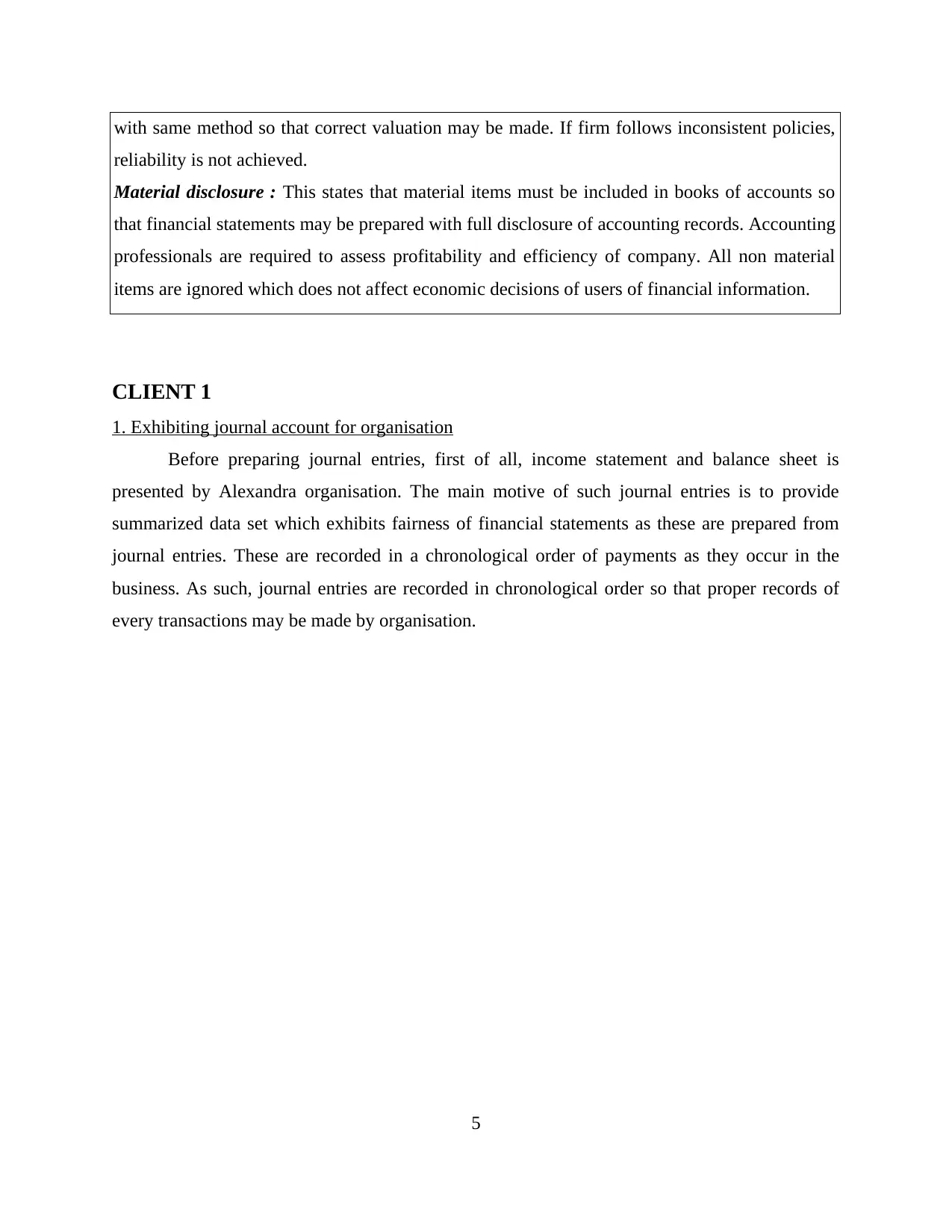
with same method so that correct valuation may be made. If firm follows inconsistent policies,
reliability is not achieved.
Material disclosure : This states that material items must be included in books of accounts so
that financial statements may be prepared with full disclosure of accounting records. Accounting
professionals are required to assess profitability and efficiency of company. All non material
items are ignored which does not affect economic decisions of users of financial information.
CLIENT 1
1. Exhibiting journal account for organisation
Before preparing journal entries, first of all, income statement and balance sheet is
presented by Alexandra organisation. The main motive of such journal entries is to provide
summarized data set which exhibits fairness of financial statements as these are prepared from
journal entries. These are recorded in a chronological order of payments as they occur in the
business. As such, journal entries are recorded in chronological order so that proper records of
every transactions may be made by organisation.
5
reliability is not achieved.
Material disclosure : This states that material items must be included in books of accounts so
that financial statements may be prepared with full disclosure of accounting records. Accounting
professionals are required to assess profitability and efficiency of company. All non material
items are ignored which does not affect economic decisions of users of financial information.
CLIENT 1
1. Exhibiting journal account for organisation
Before preparing journal entries, first of all, income statement and balance sheet is
presented by Alexandra organisation. The main motive of such journal entries is to provide
summarized data set which exhibits fairness of financial statements as these are prepared from
journal entries. These are recorded in a chronological order of payments as they occur in the
business. As such, journal entries are recorded in chronological order so that proper records of
every transactions may be made by organisation.
5
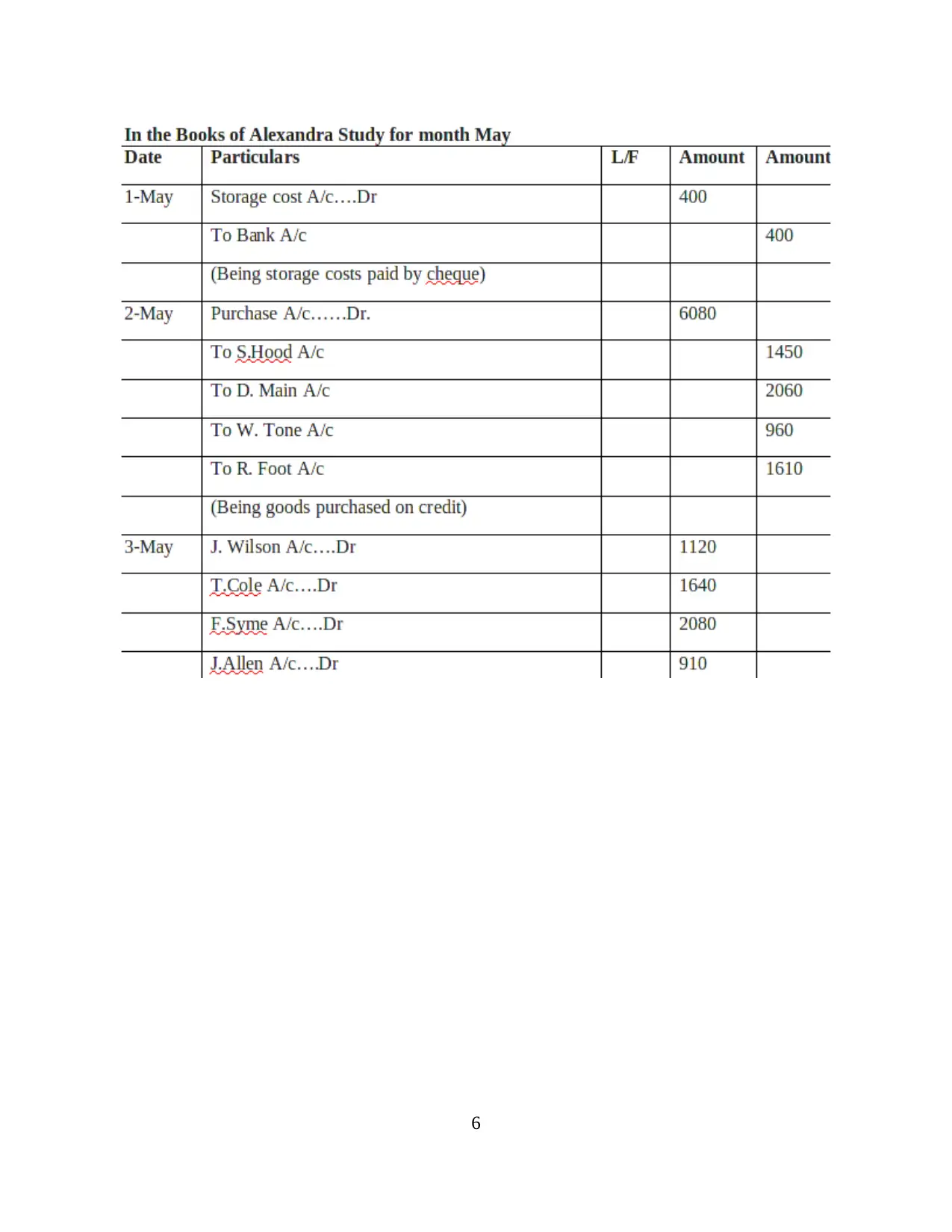
6
⊘ This is a preview!⊘
Do you want full access?
Subscribe today to unlock all pages.

Trusted by 1+ million students worldwide
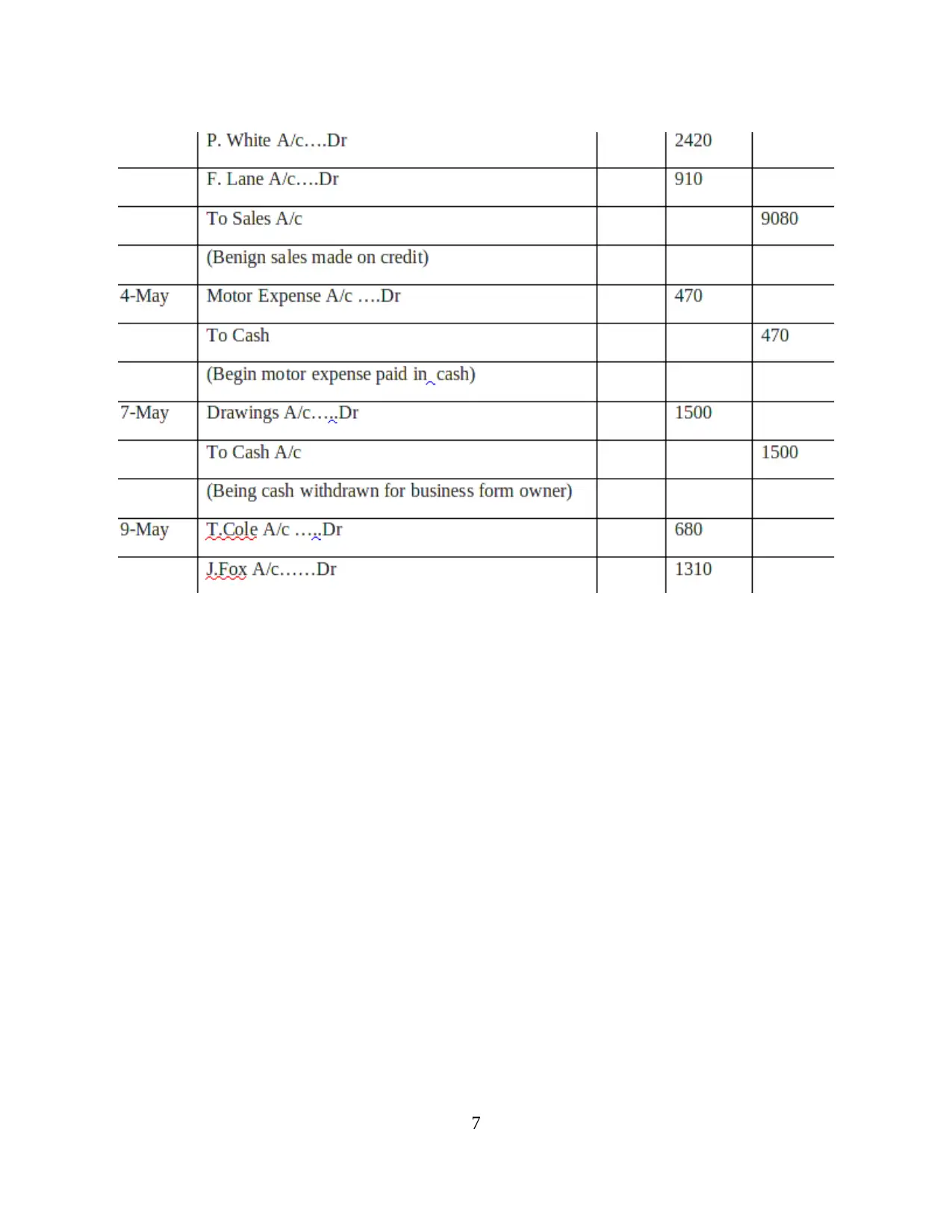
7
Paraphrase This Document
Need a fresh take? Get an instant paraphrase of this document with our AI Paraphraser
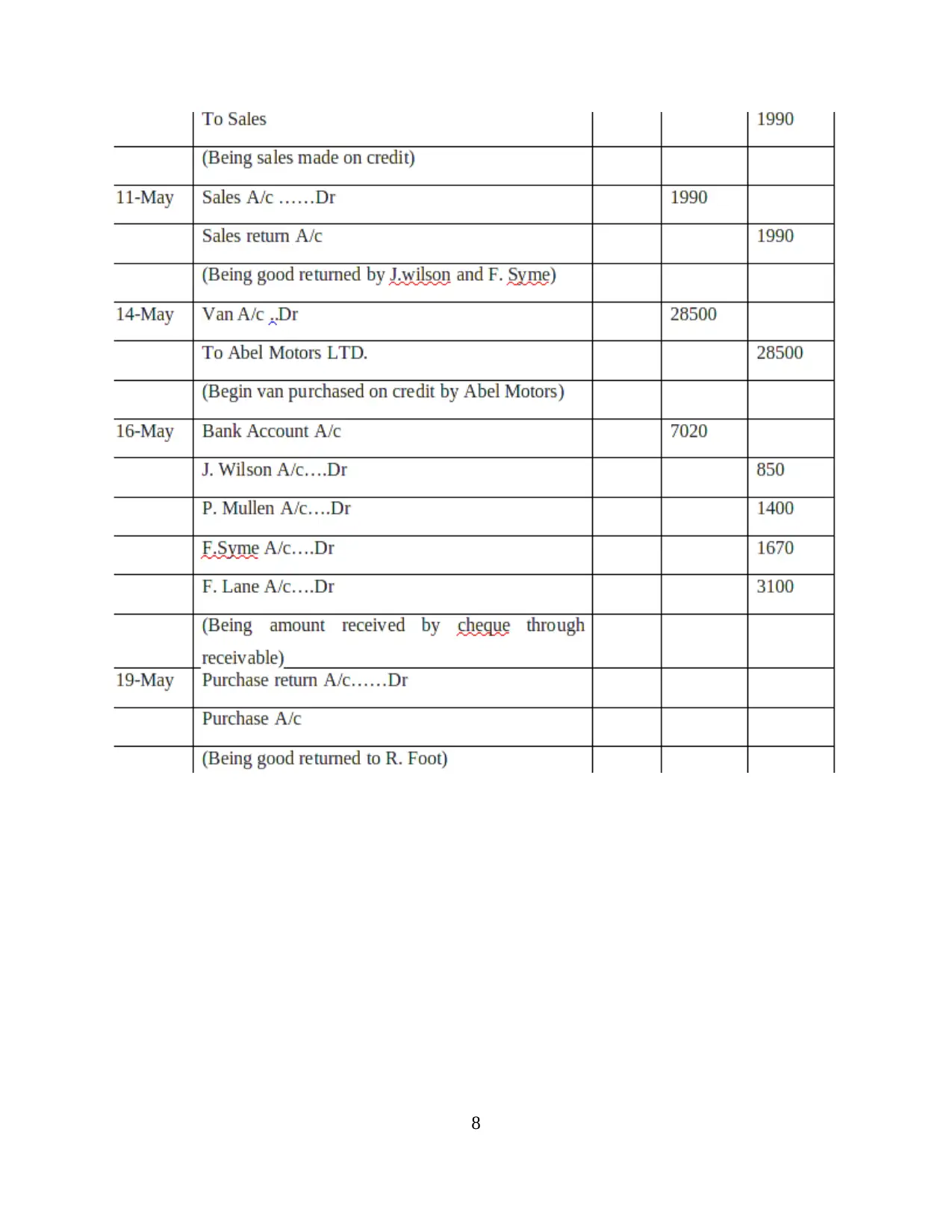
8
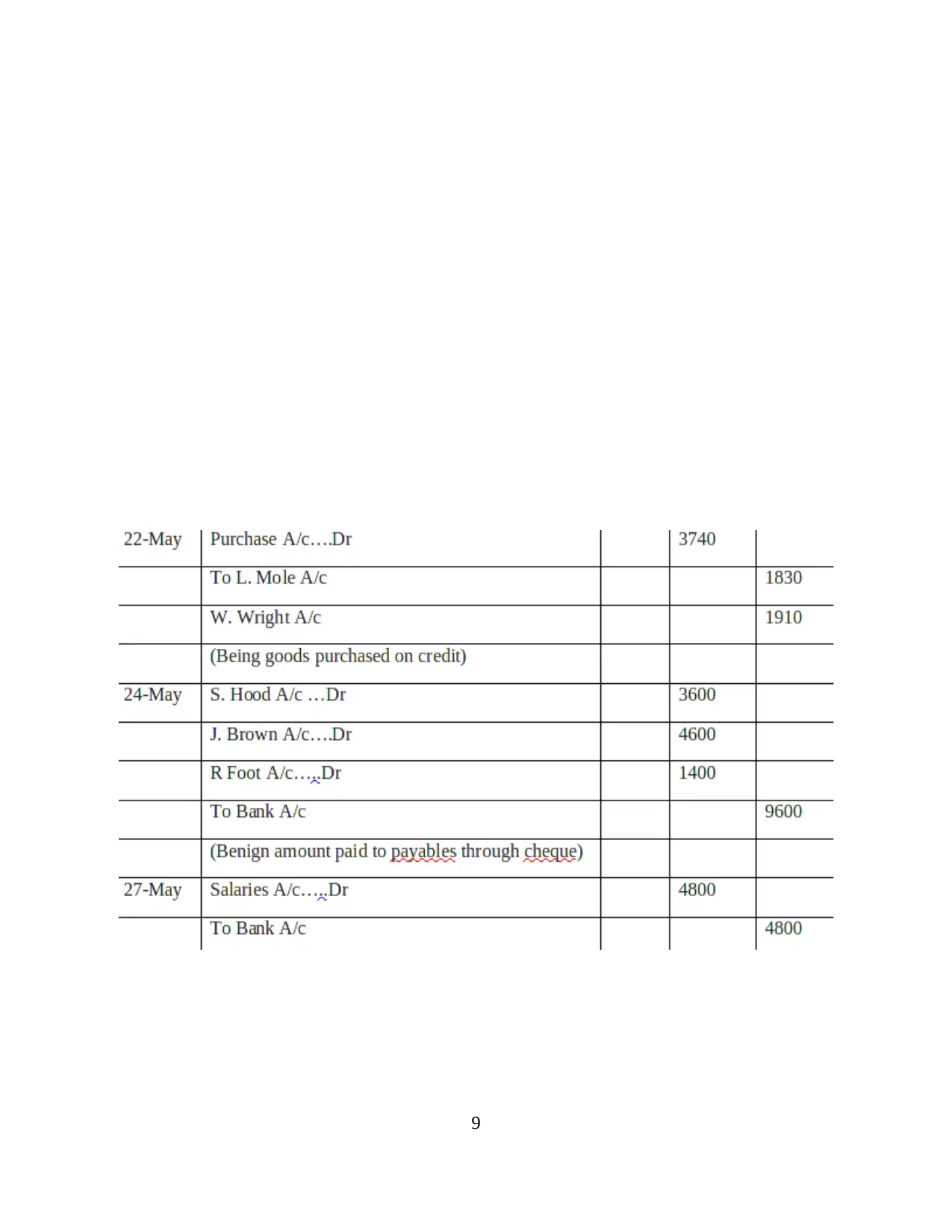
9
⊘ This is a preview!⊘
Do you want full access?
Subscribe today to unlock all pages.

Trusted by 1+ million students worldwide
1 out of 46
Related Documents
Your All-in-One AI-Powered Toolkit for Academic Success.
+13062052269
info@desklib.com
Available 24*7 on WhatsApp / Email
![[object Object]](/_next/static/media/star-bottom.7253800d.svg)
Unlock your academic potential
Copyright © 2020–2025 A2Z Services. All Rights Reserved. Developed and managed by ZUCOL.





